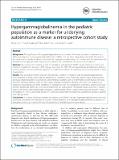| dc.contributor.author | Lo, Mindy S | en_US |
| dc.contributor.author | Zurakowski, David | en_US |
| dc.contributor.author | Son, Mary Beth F | en_US |
| dc.contributor.author | Sundel, Robert P | en_US |
| dc.date.accessioned | 2014-03-11T02:49:16Z | |
| dc.date.issued | 2013 | en_US |
| dc.identifier.citation | Lo, Mindy S, David Zurakowski, Mary Beth F Son, and Robert P Sundel. 2013. “Hypergammaglobulinemia in the pediatric population as a marker for underlying autoimmune disease: a retrospective cohort study.” Pediatric Rheumatology Online Journal 11 (1): 42. doi:10.1186/1546-0096-11-42. http://dx.doi.org/10.1186/1546-0096-11-42. | en |
| dc.identifier.issn | 1546-0096 | en |
| dc.identifier.uri | http://nrs.harvard.edu/urn-3:HUL.InstRepos:11879111 | |
| dc.description.abstract | Background: The significance of hypergammaglobulinemia as a marker of immune activation is unknown, as a differential diagnosis for hypergammaglobulinemia in children has not been adequately established. The goal of this study was to identify conditions associated with hypergammaglobulinemia in children, with the hypothesis that elevated immunoglobulin levels may precede or predict the development of autoimmune conditions. Methods: We reviewed the medical records for all children with IgG level ≥2000 mg/dL treated at a tertiary care children’s hospital from January 1, 2000 through December 31, 2009. We compared clinical and laboratory features of these patients, and developed an algorithm to predict the likelihood of underlying autoimmunity based on these characteristics. Results: After excluding children who had received IVIG, a total of 442 patients with hypergammaglobulinemia were identified. Of these, nearly half had autoimmune conditions, most frequently systemic lupus erythematosus and lupus-related disorders. Autoimmune gastrointestinal disorders such as inflammatory bowel disease were also common. Infectious diseases were the next largest category of diseases, followed with much less frequency by malignant, drug-related, and other conditions. In comparison with non-autoimmune conditions, patients with autoimmune disease had higher IgG levels, lower white blood cell counts, lower hemoglobin values, and lower C-reactive protein (CRP) levels. Multivariable logistic regression confirmed that CRP (P = 0.002), white blood cell count (P < 0.001), hemoglobin (P = 0.015), and female gender (P < 0.001) are independent risk factors for autoimmune disease in patients with high IgG levels. Conclusions: In a cohort of pediatric patients at a tertiary care children’s hospital, hypergammaglobulinemia was most commonly associated with autoimmune diseases. In female patients with hypergammaglobulinemia, the presence of leukopenia, anemia, and normal CRP was 95% predictive of underlying autoimmune disease. | en |
| dc.language.iso | en_US | en |
| dc.publisher | BioMed Central | en |
| dc.relation.isversionof | doi:10.1186/1546-0096-11-42 | en |
| dc.relation.hasversion | http://www.ncbi.nlm.nih.gov/pmc/articles/PMC3831248/pdf/ | en |
| dash.license | LAA | en_US |
| dc.title | Hypergammaglobulinemia in the pediatric population as a marker for underlying autoimmune disease: a retrospective cohort study | en |
| dc.type | Journal Article | en_US |
| dc.description.version | Version of Record | en |
| dc.relation.journal | Pediatric Rheumatology Online Journal | en |
| dash.depositing.author | Lo, Mindy S | en_US |
| dc.date.available | 2014-03-11T02:49:16Z | |
| dc.identifier.doi | 10.1186/1546-0096-11-42 | * |
| dash.contributor.affiliated | Lo, Mindy | |
| dash.contributor.affiliated | Son, Mary | |
| dash.contributor.affiliated | Sundel, Robert | |
| dash.contributor.affiliated | Zurakowski, David | |


